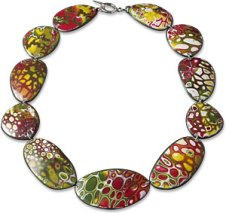Follow your heart

Polymer hearts are simple icons that are easy to make. Broken, mended, sugary, romantic, bleeding, tattooed…they come in many varieties. Being easy to make doesn’t have to mean boring. Here are a few hearts with heart.

Louise Fischer Cozzi sells translucent, thin, minimalist pendants that benefit the Heart Association on her Etsy site. The edges are carefully painted gold. Easy? Yes. Classy? Certainly.
Fairy-Cakes goes for a light-hearted pop art version with a colorful controlled swirl on her DeviantArt page.

Donna Greenberg’s chunky, sparkly mosaics speak of fashion and flair more than love and she has a new line of them. She calls these her bursting hearts. (Thanks to Sarah Connor for the link.) What does your heart look like?













